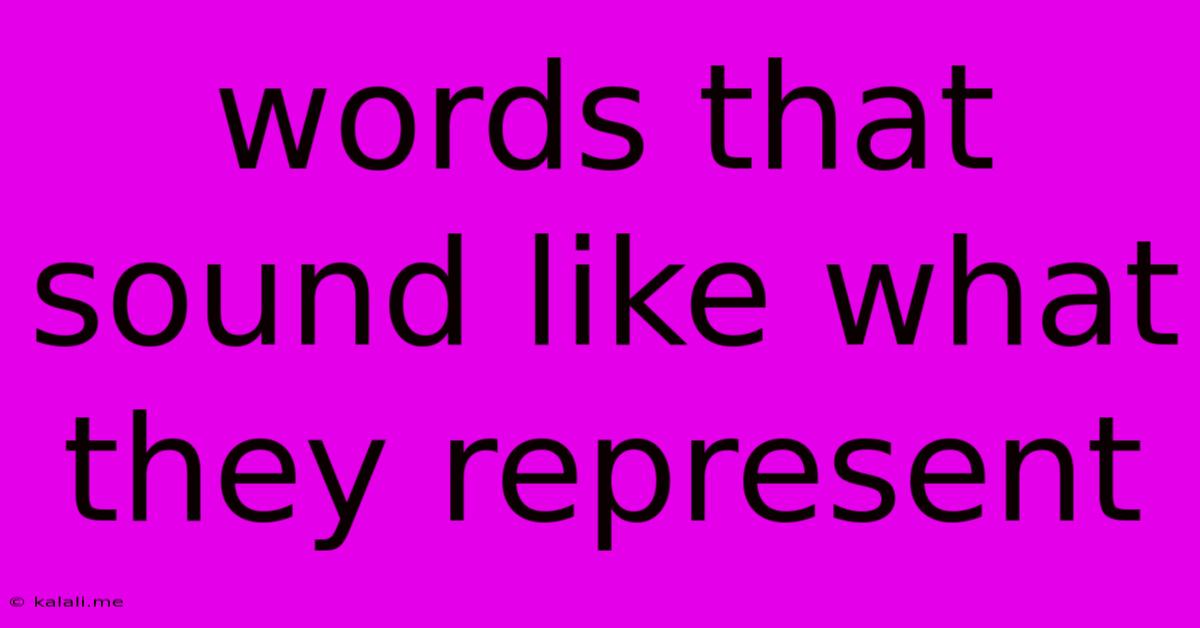Words That Sound Like What They Represent
Kalali
Jun 04, 2025 · 3 min read

Table of Contents
Words That Sound Like What They Represent: Onomatopoeia and Beyond
Onomatopoeia – the delightful phenomenon of words that mimic the sounds they describe – is a cornerstone of language, adding vibrancy and immediacy to our communication. From the buzzing of a bee to the splash of water, these words paint sonic pictures in our minds. But the magic of sound-symbolic language extends beyond pure onomatopoeia, encompassing words whose meanings are subtly suggested by their phonetic structure. This article delves into the fascinating world of words that sound like what they represent, exploring examples and the linguistic principles at play.
What is Onomatopoeia?
Onomatopoeia is the formation of a word from a sound associated with what is named. Think of the classic examples: buzz, hiss, meow, woof, splash. These words instantly evoke the sounds they represent, regardless of language. The power of onomatopoeia lies in its universality; it transcends linguistic boundaries, connecting us through shared auditory experiences. It's a fundamental building block in creating vivid and engaging narratives, poems, and even technical descriptions.
Beyond the Buzz: Sound Symbolism
While onomatopoeia is relatively straightforward, the concept of sound symbolism is broader and more nuanced. Sound symbolism refers to the association between the sounds of words and their meanings, even when the words aren't direct imitations of sounds. This often involves subtle phonetic qualities, such as:
-
Harsh consonants: Sounds like /k/, /g/, /t/, and /p/ often evoke feelings of hardness, sharpness, or abruptness. Consider words like crack, grit, stony, and punk.
-
Soft consonants: Sounds like /m/, /n/, /l/, and /w/ tend to suggest softness, smoothness, or gentleness. Think of words like murmur, liquid, mellow, and whisper.
-
Vowel sounds: High vowels like /i/ and /u/ often convey smallness or thinness, while low vowels like /a/ and /ɔ/ might suggest largeness or openness. Compare tiny and vast, for example.
Examples of Sound Symbolism in Action:
The effect of sound symbolism is often subtle but pervasive in language. Consider these examples:
- "Slippery": The repeated "s" sound creates a sense of smoothness and slipperiness.
- "Rumble": The guttural "r" and "m" sounds evoke the deep, vibrating sound of a rumbling engine.
- "Giggle": The light and airy "g" and "l" sounds mimic the lighthearted sound of laughter.
- "Clumsy": The harsh "cl" and "m" sounds suggest awkwardness and clumsiness.
The Role of Culture and Language:
It's important to note that the associations between sounds and meanings can be culturally influenced. What one culture perceives as a "hard" sound, another might perceive as "soft." While there are some universal tendencies in sound symbolism, the interpretations can vary across different languages.
Conclusion:
The inherent connection between the sounds of words and their meanings adds a significant layer of richness and artistry to language. From the blatant mimicry of onomatopoeia to the subtle suggestions of sound symbolism, these linguistic phenomena enrich our communication, making it more evocative, memorable, and engaging. Understanding these principles can enhance your own writing, allowing you to craft more impactful and memorable prose. By consciously employing sound symbolism, you can create text that resonates not only intellectually but also emotionally and aesthetically with your readers.
Latest Posts
Latest Posts
-
Remove Types Of Files You Cans Earch For On Alfred
Jun 06, 2025
-
How Many Amps Does A Washer Use
Jun 06, 2025
-
Reliance 31410crk Transfer Switch Internal Wiring Diagram
Jun 06, 2025
-
A Group Of Scorpions Is Called
Jun 06, 2025
-
R Does The Biggest Cook Distance Point Outlier
Jun 06, 2025
Related Post
Thank you for visiting our website which covers about Words That Sound Like What They Represent . We hope the information provided has been useful to you. Feel free to contact us if you have any questions or need further assistance. See you next time and don't miss to bookmark.